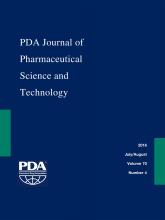Abstract
Container closure integrity (CCI) testing is required by different regulatory authorities in order to provide assurance of tightness of the container closure system against possible contamination, for example, by microorganisms. Microbial ingress CCI testing is performed by incubation of the container closure system with microorganisms under specified testing conditions. Physical CCI uses surrogate endpoints, such as coloration by dye solution ingress or gas flow (helium leakage testing). In order to correlate microbial CCI and physical CCI test methods and to evaluate the methods' capability to detect a given leak, artificial leaks are being introduced into the container closure system in a variety of different ways. In our study, artificial leaks were generated using inserted copper wires between the glass vial opening and rubber stopper. However, the insertion of copper wires introduces leaks of unknown size and shape. With nonlinear finite element simulations, the aperture size between the rubber stopper and the glass vial was calculated, depending on wire diameter and capping force. The dependency of the aperture size on the copper wire diameter was quadratic. With the data obtained, we were able to calculate the leak size and model leak shape. Our results suggest that the size as well as the shape of the artificial leaks should be taken into account when evaluating critical leak sizes, as flow rate does not, independently, correlate to hole size. Capping force also affected leak size. An increase in the capping force from 30 to 70 N resulted in a reduction of the aperture (leak size) by approximately 50% for all wire diameters. From 30 to 50 N, the reduction was approximately 33%.
LAY ABSTRACT: Container closure integrity (CCI) testing is required by different regulatory authorities in order to provide assurance of tightness of the container closure system against contamination, for example, by microorganisms. Microbial ingress CCI testing is performed by incubation of the container closure system with microorganisms under specified testing conditions. Physical CCI uses surrogate endpoints, such as coloration by dye solution ingress or gas flow. In order to correlate microbial ingress CCI and physical CCI test methods and to evaluate the methods' capability to detect a given leak, artificially created defects (artificial leaks) are being introduced into the container closure system in a variety of different ways. In our study, artificial leaks were generated using inserted copper wires between the glass vial opening and rubber stopper. Up to date, the insertion of copper wires introduced leaks of unknown size and shape. With nonlinear finite element simulations, the effective aperture size between the rubber stopper and the glass vial was calculated, depending on wire diameter and capping force, and the leak shape was modelled. Our results suggest that the size as well as the shape of the artificial leaks should be taken into account when evaluating critical leak sizes, as flow rate does not, independently, correlate to the hole size.
- Container closure integrity
- Artificial leaks
- Helium leak test
- Sterility
- Microbiological quality
- Finite element simulations
- Capping
Footnotes
At the author's request, this version of the article contains a correction added on August 3, 2016: Page 319, equation 1 originally posted as:
 has now been corrected to:
has now been corrected to:

- © PDA, Inc. 2016
PDA members receive access to all articles published in the current year and previous volume year. Institutional subscribers received access to all content. Log in below to receive access to this article if you are either of these.
If you are neither or you are a PDA member trying to access an article outside of your membership license, then you must purchase access to this article (below). If you do not have a username or password for JPST, you will be required to create an account prior to purchasing.
Full issue PDFs are for PDA members only.
Note to pda.org users
The PDA and PDA bookstore websites (www.pda.org and www.pda.org/bookstore) are separate websites from the PDA JPST website. When you first join PDA, your initial UserID and Password are sent to HighWirePress to create your PDA JPST account. Subsequent UserrID and Password changes required at the PDA websites will not pass on to PDA JPST and vice versa. If you forget your PDA JPST UserID and/or Password, you can request help to retrieve UserID and reset Password below.








